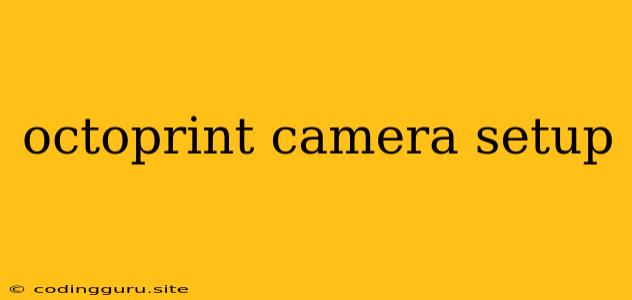OctoPrint Camera Setup: A Guide to Enhancing Your 3D Printing Experience
Are you tired of constantly checking on your 3D printer, eager to see how your print is progressing? Imagine a world where you can monitor your print live, from the comfort of your couch or even across the globe. This is the power of OctoPrint's camera integration.
OctoPrint, a popular web interface for managing your 3D printer, offers the ability to connect a camera and stream live video feed directly to your browser. This is a game-changer for 3D printing enthusiasts, offering numerous benefits:
- Real-time monitoring: Observe your print as it happens, allowing you to catch any potential issues early on.
- Remote control: Start, stop, and pause your prints remotely, even from your phone or tablet.
- Time-lapse creation: Capture stunning time-lapses of your prints, showcasing the entire process from start to finish.
But how do you set up an OctoPrint camera? Let's break down the process step by step:
1. Choosing the Right Camera
The first step is selecting a compatible camera. OctoPrint supports a wide range of options, from USB webcams to network cameras (IP cameras). Here are some popular choices:
- USB Webcams: These are the most readily available and often the most budget-friendly option. Look for webcams with decent resolution (at least 720p) and a wide field of view for optimal coverage of your print bed.
- Network Cameras (IP Cameras): If you want a more robust solution with higher resolution and potentially greater flexibility, network cameras are a great choice. These cameras connect directly to your network, offering a wider range of viewing angles and features.
Tip: When choosing a camera, make sure it's compatible with OctoPrint. Check the OctoPrint documentation for a list of supported models.
2. Connecting Your Camera
Once you have your camera, it's time to connect it to your OctoPrint system. The connection process varies depending on the type of camera you've chosen:
- USB Webcams: Simply plug the webcam into a USB port on your Raspberry Pi (running OctoPrint). OctoPrint should automatically detect the camera and configure it.
- Network Cameras (IP Cameras): You'll need to configure the IP camera to stream its video feed over your network. This typically involves accessing the camera's settings via its web interface and enabling RTSP (Real-Time Streaming Protocol). You'll then need to provide the camera's IP address and RTSP stream URL to OctoPrint.
Tip: If you're unsure how to connect your IP camera, consult the camera's documentation or search for online tutorials.
3. Configuring OctoPrint
After connecting your camera, you'll need to configure OctoPrint to use it. This involves a few simple steps:
- Open the OctoPrint web interface: Access OctoPrint's web interface by navigating to your Raspberry Pi's IP address in your web browser.
- Navigate to Settings: Click on the "Settings" icon in the sidebar.
- Go to "Camera": Find the "Camera" section under "Plugins."
- Select your camera: Choose the camera you've connected from the dropdown menu.
- Configure settings (if necessary): Some cameras might require additional settings, such as specifying the RTSP stream URL or authentication credentials.
- Save your changes: Click on "Save Settings" to apply the configurations.
Tip: After configuring your camera, refresh OctoPrint's web interface to ensure it's working correctly.
4. Viewing the Live Stream
Once you've successfully configured your camera, you should see a live video feed of your 3D printer on the OctoPrint interface. You can now monitor your print in real-time, even from a different room or across the world!
5. Time-lapse Creation
One of the best features of OctoPrint's camera integration is its time-lapse functionality. You can capture the entire printing process, from start to finish, in a condensed and visually stunning time-lapse video.
To create a time-lapse, follow these steps:
- Enable the Time-lapse Plugin: Navigate to the "Plugins" section in OctoPrint's settings and enable the "Time-lapse Plugin."
- Choose your settings: Customize your time-lapse settings, such as frame rate, resolution, and file format.
- Start your print: Begin printing your desired model.
- Capture the time-lapse: OctoPrint will automatically capture images throughout the print process, creating a seamless time-lapse video.
- Download the time-lapse: Once the print is complete, you can download the generated time-lapse video from the OctoPrint interface.
Tip: Experiment with different time-lapse settings to find the perfect balance between video length and detail.
Troubleshooting
If you encounter any problems during the setup process, here are some common troubleshooting steps:
- Check your camera connection: Make sure the camera is securely connected and powered on.
- Verify OctoPrint settings: Double-check that you've correctly configured your camera in OctoPrint's settings.
- Ensure network connectivity: If you're using a network camera, make sure it's connected to the same network as your Raspberry Pi.
- Update OctoPrint and plugins: Outdated versions of OctoPrint or plugins might cause compatibility issues. Update to the latest versions for optimal performance.
Conclusion
Setting up an OctoPrint camera is a straightforward process that can significantly enhance your 3D printing experience. With a live video feed, you can monitor your prints, control your printer remotely, and create captivating time-lapses. Experiment with different camera options and settings to find the best configuration for your setup. Enjoy the peace of mind and improved monitoring capabilities that OctoPrint's camera integration offers.
